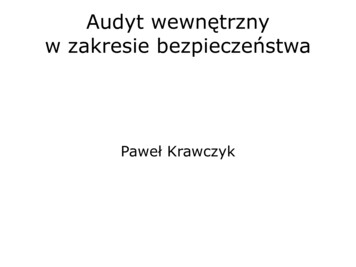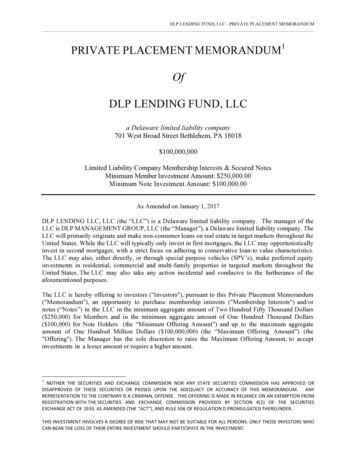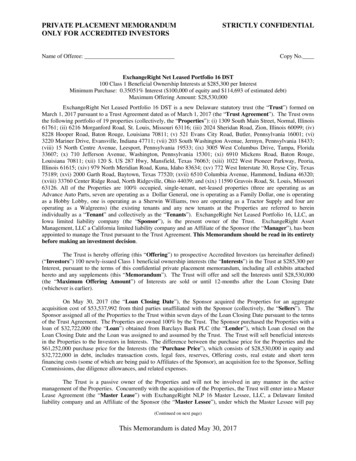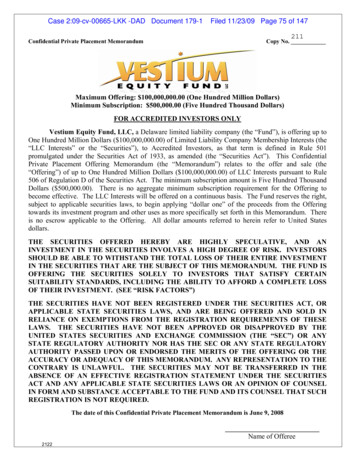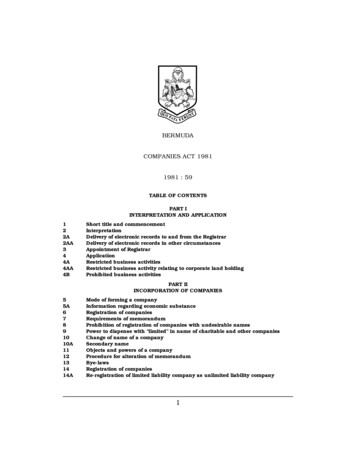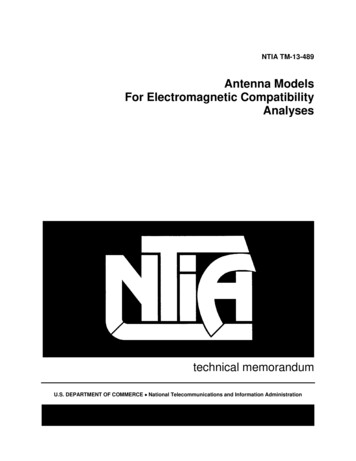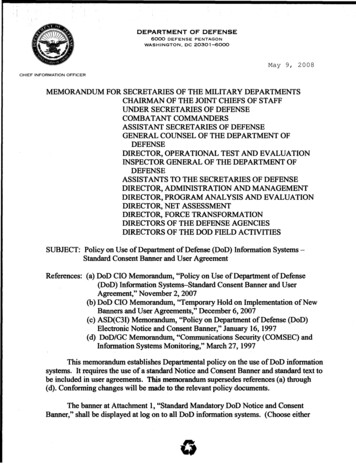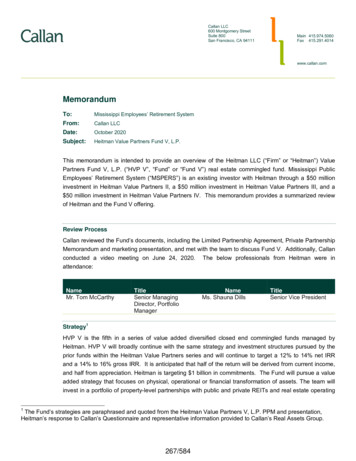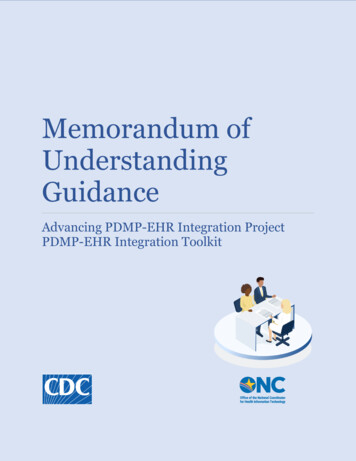
Transcription
Memorandum ofUnderstandingGuidanceAdvancing PDMP-EHR Integration ProjectPDMP-EHR Integration Toolkit0 PDMP-EHR Integration Toolkit: Memorandum of Understanding Guidance
This document was developed by Accenture Federal Services as the contractor leading the AdvancingPrescription Drug Monitoring Programs - Electronic Health Record (PDMP-EHR) IntegrationProject under contract #GS-35F-540GA order # HHSP233201800327G. The project team fromAccenture Federal Services served as a contractor to the Office of the National Coordinator forHealth Information Technology (ONC). ONC served as the implementer partner to the Centers forDisease Control and Prevention (CDC). Funding for this contract award was provided by the CDC.The PDMP-EHR Integration Toolkit was developed based on lessons learned by the Accenture teamthrough collaborations with PDMP-EHR integration technical demonstration sites and ClinicalDecision Support Proofs-of-Concept sites that participated in the Advancing PDMP-EHR IntegrationProject from 2018 - 2021. The PDMP-EHR Integration Toolkit is supplemented by the IntegrationFramework.The findings and conclusions in this document are those of the authors and do not necessarilyrepresent the official position of, the Centers for Disease Control and Prevention/the Agency for ToxicSubstances and Disease Registry, the Office of the National Coordinator for Health InformationTechnology, or the other organizations involved, nor does the mention of trade names, commercialproducts, or organizations imply endorsement by the U.S. Government.i PDMP-EHR Integration Toolkit: Memorandum of Understanding Guidance
Table of ContentsPurpose . 1Background . 1Sample MOU Areas of Consideration . 1Appendix . 3ii PDMP-EHR Integration Toolkit: Memorandum of Understanding Guidance
PurposeThis document translates lessons learned from the Officeof the National Coordinator for Health InformationTechnology/Centers for Disease Control and Prevention(ONC/CDC) Advancing Prescription Drug MonitoringProgram Electronic Health Record (PDMP-EHR)Integration Project into general Memorandum ofUnderstanding (MOU) guidance. The MOU Guidance isone of several documents within the PDMP-EHRIntegration Toolkit and provides key topics and pointsfor consideration in developing PDMP-EHR dataintegration and sharing agreements. The intendedaudience for this document is State PDMPAdministrators, to assist them in developing theirPDMP-EHR Integration MOU document for review withhealth care systems in their state. This guidance isdesigned to be used alongside the MOU template foundin the Appendix of this document.BackgroundThis document lists key topics often found in MOUs that require careful articulation to supportstreamlined data sharing between PDMPs and health care systems, institutions, or vendors. Thesetopics are collected from conversations and work with State PDMP Administrators pursuingintegration initiatives. Enhanced clarity in MOU language is often necessary because counsel forhealth care systems may be unfamiliar with the nuanced application of PDMP data access, use, anddisclosure provisions.Enhanced clarity in MOU language is often necessary because counsel for healthcare systems may be unfamiliar with the nuanced application of PDMP dataaccess, use, and disclosure provisions.Sample MOU Areas of ConsiderationAutomatic versus Practitioner Initiated Queries. Some states require each query to be for anindividual patient and to be practitioner initiated. Some states allow health care systems to generateautomated queries to pull PDMP data for patients with appointments the following day.Storage and Format of the PDMP data. Some states allow storage of the PDMP data in thepatient's medical record within the EHR but may require the health care facility to meet staterequirements regarding how and where data are stored. The permitted format of the stored PDMPdata varies among states. At least one state only allows the storage of PDMP data in the medical recordas a PDF attachment. Other states permit discrete PDMP data elements to be stored in the medicalrecord, as approved by the State PDMP Administrator. Other states only allow a view of the PDMPdata from within the EHR and prohibit actual storage within the EHR system.Access/Disclosure of Stored PDMP Data. States should specify which disclosure laws andpolicies govern the stored PDMP data. Some states allow the access and disclosure rules that governother data in the medical record to also govern the stored PDMP data. These states often deem thestored PDMP data to be a medical record or medical or health information. The stored PDMP data aresubject to the state and federal privacy and confidentiality policies that govern other such records orinformation. It is also advisable for a state to clarify any PDMP disclosure restrictions that it wishes to1 PDMP-EHR Integration Toolkit: Memorandum of Understanding Guidance
retain for the stored PDMP data. For example, proper retrieval of the information contained within alegal health record requires subpoenas or court orders for use in civil suits or other legal proceedings.Some states prohibit the State PDMP Administrator from disclosing PDMP data for use in certain civilproceedings. If a state wants to subject health care systems to a comparable disclosure restriction, thestate should outline the circumstances in which disclosure is prohibited. Additionally, states shouldspecify which login credentials clinicians may use to request PDMP data. Some states require cliniciansto use their PDMP credentials, while others permit the use of EHR credentials.Use of the Stored PDMP Data. Health care systems may beunaware of the numerous differences in data governancebetween PDMP laws and policies and other health care laws andpolicies. These entities sometimes assume that they and theirclinicians can use PDMP data stored in the medical record asthey would other information in the record. For example, ChiefMedical Officers and Medical Directors sometimes ask if theirinstitutions can include PDMP data with other patient datamaintained within their EHR systems to conduct analyses ofpatient use and prescribing behaviors. Whether such data use ispermitted varies by state. States sometimes prevent themanipulation of the PDMP data. Other states may authorize theState PDMP Administrator to permit the use of discrete PDMPdata elements for clinical decision support or patient carepurposes on an individual case basis.Data Interpretations/Summaries. States generally allow health care clinicians to review and useinterpretations or summaries of PDMP data, such as risk scores. At least one state permits storage inthe medical record of an interpretation or summary with, but not in lieu of, PDMP data. However,some states have policies or legal opinions that a clinician's review of such an interpretation orsummary does not by itself comply with a state's mandate to review a patient's PDMP data. A stateshould clarify whether a clinician's review of a PDMP data interpretation or summary satisfies thestate's mandated PDMP use provision.Log of PDMP Data Requests. States generally specify the type of information that health caresystems must maintain regarding who has requested PDMP data and when each request was made.The entities often have to provide the information upon request by the State PDMP Administrator.Sometimes states also require reporting to the State PDMP Administrator regularly, such as monthlyor quarterly.Notification of Breaches. States often outline a process by which health care systems have to notifythe State PDMP Administrator of breaches that may impact the receipt and/or storage of PDMP datain the EHR system. This process usually details notification procedures and the state's authority tosuspend access by an individual clinician or the EHR system's connection to the PDMP pending query.In addition, the process usually indicates that the state, if necessary, will terminate the clinician'saccess or the EHR system's connection.Required Education and Monitoring. States often require health care institutions to educatetheir clinicians about the proper access, disclosure, and use of the PDMP data. Additionally, statesrequire institutions to properly monitor their clinicians to ensure the clinicians' compliance with allrelevant laws, regulations, and policies. States should require institutions to document that theirclinicians have received the proper instruction so that documentation is readily available to the StatePDMP Administrator upon request.Required State View of Integrated PDMP Data Display. States need to confirm that theintegrated PDMP data display complies with state statutes, regulations, and implementationrequirements. If states have the authority to view the integration display or expect to take otherreasonable compliance monitoring measures during the integration testing and approval phases, thestate should include those requirements in the MOU. States should also include the authority to take2 PDMP-EHR Integration Toolkit: Memorandum of Understanding Guidance
reasonable measures to investigate complaints or information received regarding the EHR system’spossible noncompliance.AppendixSample MOU TemplateDisclaimerA sample MOU template is provided below. Readers should consider consulting with an attorneyemployed by or contracted by their department or agency for assistance in crafting MOUs or otheragreements to permit integration between PDMPs and health IT systems while complying withrelevant legal and regulatory requirements. This sample MOU is a working draft that does not reflectany specific state or approved MOU. The sample template is a composite of multiple MOUs fromdifferent states and incorporates common themes that may be helpful to consider when draftingstate and health IT integration agreements.TemplateThis data sharing agreement is entered into on (Effective Date) by and betweenthe [insert name of appropriate state agency] (Agency) and ,a company organized under the laws of or authorized to do business in the State of [insert name ofstate] (Participant).SECTION 1. PURPOSE.This agreement is intended to provide a secure and efficient method by which health care professionalsmay access and use PDMP data through Participant’s electronic health record system (EHR).SECTION 2. DEFINITIONS.For the purposes of this Agreement, the following words and phrases shall have the meanings giventhem in this Section.(a) “Applicable laws and standards” means all applicable state and federal laws, statutes, acts,regulations, rules, standards, policies, guidelines, conditions and judicial or administrative rulings,orders, or opinions. Such laws and standards include, but are not limited to: [insert citations toappropriate state statutes]; the Health Insurance Portability and Accountability Act of 1996(HIPAA), Pub. L. No. 104-191 (Aug. 21, 1996), 45 C.F.R. parts 160 and 164 (HIPAA Privacy and SecurityRules); the federal confidentiality law and regulations, 42 U.S.C. § 290dd-2, 42 C.F.R. Part 2;standards of the Centers for Medicare and Medicaid Services Conditions of Participation; andstandards of accrediting agencies such as the Joint Commission on Accreditation of Health careOrganizations.(b) “Health care” means health care as defined in [insert citation to §160.103 of HIPAA orapplicable state definition].(c) “Health care professional” means an individual licensed by the State of [insert name of state]to provide health care who is employed by or under contract with Participant to provide such care onbehalf of Participant.(d) “Health record” means [OPTION 1: the record of health care provided to a patient by allhealth care professionals involved in the patient’s care that is designed to be accessedby all such professionals and the patient.] [OPTION 2: insert citation to applicable statedefinition.](e) “Patient” means an individual who (1) has received or is receiving health care from a health careprofessional or (2) who seeks health care from a health care professional and for whom theprofessional affirmatively acts to provide such care, or agrees to do so.(f) “PDMP” means the prescription drug monitoring program established and operated pursuant to[insert citation to state PDMP statute and regulations].3 PDMP-EHR Integration Toolkit: Memorandum of Understanding Guidance
(g) “PDMP data” means data that are collected, maintained, managed and disclosed by the PDMP.SECTION 3. GRANT OF RIGHT TO ACCESS THE PDMP.(a) The Agency grants to Participant a nonexclusive, nontransferable, nonassignable, nonsublicensable, and limited right to access the PDMP and make PDMP data available through Participant’sEHR. Participant shall maintain a secure environment in compliance with this Agreement andapplicable laws and standards to connect to the PDMP and to permit access, use and disclosure ofPDMP data through Participant’s EHR.(b) Participant shall be responsible for all costs associated with the installation, modification andmaintenance of hardware and software necessary to maintain a secure environment. The Agency shallnot levy any service fees or charges for access, use and disclosure of PDMP data pursuant to thisAgreement.SECTION 4. ACCESS, USE, AND DISCLOSURE OF PDMP DATA IN EHR.(a) Participant shall only make PDMP data available to its designated non-health care employees,contractors or agents and health care professionals.(b) Designated non-health care employees, contractors, or agents:(i) May access, use, and disclose PDMP data only as necessary to facilitate Participant’scompliance with this Agreement and applicable laws and standards and(ii) Shall comply with the terms and conditions of this Agreement and applicable laws andstandards, to the same extent Participant is required to comply.(c) Health care professionals [OPTION 1: may use EHR credentials provided by Participant to requestPDMP data.][OPTION 2: shall use credentials provided by the PDMP to request PDMP data.] Healthcare professionals shall only request PDMP data as required or allowed by applicable laws andstandards and shall submit such requests by one of the following methods:(i) A health care practitioner may initiate a PDMP request for a single patient or(ii) Participant may submit a single, automated request for the PDMP data of patients withappointments at Participant’s location the next business day.(d) Participant may store the PDMP data in a patient’s health record in a format authorized by theAgency. PDMP data in a health record may be stored for the same duration as other patientinformation stored in that record. At no time during storage shall Participant alter, edit, or modify thePDMP data. As authorized by the Agency, Participant may copy or incorporate the PDMP data into asearchable computer program or database for clinical decision support or health care operations asdefined by [insert citation to §164.501 of HIPAA or appropriate state definition of “healthcare operations”]. Summaries or interpretations of the PDMP data may be stored with but not inlieu of the PDMP data. Except as authorized by the Agency, health care professionals shall not usesummaries or interpretations in lieu of PDMP data to comply with applicable laws and standards.(e) PDMP data stored in a patient’s health record shall be disclosed on the same terms and conditionsas other patient information stored in that record. [Insert any state requirements orrestrictions on how or to whom Participant may disclose the PDMP data.]SECTION 5. MANAGEMENT AND MONITORING OF PDMP DATA IN EHR.(a) Participant shall maintain, and provide to the Agency upon its request, a written policy for themanagement of PDMP data access, use, and disclosure. The policy shall contain a description ofParticipant’s internal procedures for:(i) Educating designated non-health care employees, contractors or agents and health careprofessionals on access, use, and disclosure of PDMP data in compliance with this Agreementand applicable laws and standards;(ii) Imposing discipline or sanctions for non-compliant access, use or disclosure of PDMP data;4 PDMP-EHR Integration Toolkit: Memorandum of Understanding Guidance
(iii) Auditing the access, use or disclosure of PDMP data by designated non-health careemployees, contractors or agents and health care professionals and(iv) Detecting access, use or disclosure by unauthorized individuals or entities.(b) Participant shall make all reasonable changes to the policy deemed necessary by the Agency forParticipant to maintain a secure environment in compliance with Section 3.(c) Participant shall provide to the Agency all information and reports that the Agency deems necessaryto monitor and investigate compliance with this Agreement and applicable laws and standards.Participant shall provide the information and reports as requested by, or on a frequency establishedby, the Agency.(d) Each designated non-health care employee, contractor or agent and health care professional shallsign a statement acknowledging the responsibility of the employee, contractor, agent or professionalto access, use, and disclose PDMP data in compliance with this Agreement and applicable laws andstandards. Participant shall provide to the Agency upon its request a copy of the signed statement of aspecified employee, contractor, agent or professional.(e) Participant shall notify the Agency in writing if it detects any access, use or disclosure of PDMPdata by a designated non-health care employee, contractor or agent or health care professional that ithas reason to believe is seriously non-compliant with this Agreement or applicable laws and standards.Serious non-compliance means access, use or disclosure of PDMP data that:(i) compromises the confidentiality of the PDMP data,(ii) adversely affects the operation of the PDMP or(iii) adversely affects the legal liability of the Agency.The notice shall be without unreasonable delay and in no case later than [insert X days] followingdetection of the possibly serious non-compliance. The notice shall include:(i) A brief description of the possibly serious non-compliance,(ii) A description of the PDMP data elements involved in the possibly serious non-complianceand(iii) Steps Participant is taking to investigate the possibly serious non-compliance.Participant shall provide to the Agency investigative findings that:(i) Indicate whether serious non-compliant access, use or disclosure occurred,(ii) Outline steps Participant is taking to mitigate any harm, and(iii) Identify measures being implemented to prevent further instances of serious noncompliance.(f) Upon receipt of notice pursuant to subsection (e), the Agency shall temporarily suspend the accessto PDMP data of a designated non-health care employee, contractor or agent or health careprofessional under investigation by Participant for possibly serious non-compliance. Upon receipt offindings pursuant to subsection (e), the Agency shall terminate the access to PDMP data of theemployee, contractor, or agent or professional found to be in serious non-compliance. Participant shalltake all reasonable steps to prevent access, use or disclosure of PDMP data by the employee,contractor, agent or professional whose access has been temporarily suspended or terminated.(g) If the Agency discovers, other than by Participant’s notice, serious non-compliant access, use ordisclosure by a designated non-health care employee, contractor or agent or health care professional,the Agency shall terminate the access to PDMP data of that employee, contractor, agent orprofessional. The Agency shall notify Participant in writing of its discovery of the serious noncompliance and the termination of access to PDMP data. The notice shall be without unreasonabledelay and in no case later than [insert X days] following the discovery of the serious non-compliance.5 PDMP-EHR Integration Toolkit: Memorandum of Understanding Guidance
(h) Participant shall notify the Agency in writing if it detects access, use or disclosure by unauthorizedindividuals or entities. The notice shall be without unreasonable delay and in no case later than[insert X days] following detection of the unauthorized access, use or disclosure.(i) Participant shall notify the Agency in writing if Participant discovers that it has failed to maintaina secure environment as required by Section 3. The notice shall be without unreasonable delay and inno case later than [insert X days] following discovery of the failure. Upon receipt of notice, theAgency shall temporarily suspend Participant’s access to the PDMP. If the Agency discovers, otherthan by Participant’s notice, Participant’s failure to maintain a secure environment as required bySection 3, the Agency shall temporarily suspend Participant’s access to the PDMP. The Agency shallnotify Participant in writing of the Agency’s discovery of the failure and the temporary suspension ofaccess. Participant shall take, at Participant’s expense, all reasonable steps identified by the Agency tocure the failure. Participant’s inability to restore a secure environment within [insert X days] aftersending the Agency notice or receiving notice from the Agency pursuant to this subsection may resultin the Agency’s termination of this Agreement pursuant to Section 7.SECTION 6. TERM OF AGREEMENT.This Agreement will commence on the Effective Date and will remain in effect for an initial term of[insert X years]. Thereafter, this Agreement shall automatically renew for successive terms of one(1) year, unless either the Agency or Participant provides the other with written notice of non-renewalnot less than [insert X days] prior to the expiration date of the then-current term.SECTION 7. TERMINATION OF AGREEMENT AND EFFECT.(a) Either the Agency or Participant shall have the right to immediately terminate this Agreement tocomply with any change in applicable laws or standards, or interpretations thereof.(b) Either the Agency or Participant, upon giving written notice to the other, may terminate thisAgreement if the other breaches any material provision of this Agreement and fails to cure such breach,or fails to commence and continuously maintain substantial efforts to cure, within [insert X days]after receipt of written notice from the other.(c) Either the Agency or Participant, upon [insert X days] prior written notice to the other, mayterminate this Agreement without cause.(d) Upon termination, Participant’s right to access the PDMP under Section 3 shall immediately cease.All PDMP data accessed by Participant pursuant to Section 3 shall continue to be stored, accessed,used, and disclosed pursuant to the terms and conditions of this Agreement.SECTION 8. INDEMNIFICATION.Participant shall defend, indemnify and hold harmless the Agency from and against any liability, claim,action, loss, damage, or expenses, including court costs and reasonable attorneys’ fees, based on anythird-party claims arising out of, or relating to, Participant’s access, storage, use or disclosure of PDMPdata in violation of this Agreement.SECTION 9. WARRANTIES AND LIMITATION OF LIABILITY.(a) The Agency makes no warranty that access to the PDMP pursuant to Section 3 will be error-free oruninterrupted or that all errors will be corrected. No advice or information, whether oral or written,obtained from the Agency or elsewhere will create any warranty not expressly stated in this Agreement.(b) The Agency makes no warranty and assumes no liability related to the accuracy, currency, orcompleteness of the PDMP data that Participant accesses pursuant to Section 3.(c) Participant warrants to the best of its knowledge that neither it, nor any of its designated nonhealth care employees, contractors or agents or health care professionals, have been convicted of orotherwise legally found in violation of applicable laws and standards. Participant shall inform theAgency if at any point during the term of this Agreement such a conviction or legal ruling occurs.6 PDMP-EHR Integration Toolkit: Memorandum of Understanding Guidance
(d) Neither the Agency nor Participant shall be liable to the other or to any third party for anyincidental, indirect, special, punitive, exemplary, or consequential damages arising out of or inconnection with this Agreement.SECTION 10. GENERAL.(a) This Agreement shall be binding on the Agency and Participant, their successors and permittedassigns. Neither the Agency nor Participant shall assign or transfer this Agreement, or any part thereof,without the prior written consent of the other.(b) This Agreement does not create in any natural person, corporation, partnership, or organizationany benefits or rights and this Agreement will be effective only as to the Agency and Participant, andtheir successors and assigns.(c) The Agency and Participant are independent contractors. This Agreement shall not establish apartnership, joint venture, agency or any other relationship between the Agency and Participant.(d) This Agreement shall be governed by and construed in accordance with the laws of the State of[insert name of state] without reference to or application of conflict of laws rules or principles.(e) This Agreement sets forth the entire and only Agreement between the Agency and Participantrelated to the subject matter herein. Any representation, promise or condition, whether oral or written,not incorporated herein shall not be binding upon the Agency or Participant.(f) This Agreement may be modified, altered, or amended only by express written consent of theAgency and Participant.(g) Notice required by this Agreement shall be delivered by (1) certified mail, return receipt requested;(2) first-class mail, postage prepaid; (3) email transmission; (4) facsimile transmission or (5) expressor overnight carrier. Notice shall be deemed effective when the sender receives delivery confirmationof the certified mail, email or fax transmission or carrier or [insert X days] after the postmark of anynotice placed into the U.S. mail.(h) Neither the Agency nor Participant shall be liable for any failure or delay in performing itsobligations under this Agreement beyond its reasonable control, including war, terrorism, riot, acts ofGod or governmental action.(i) Nothing in this Agreement shall be construed to restrict the right of the Agency or Participant topursue all remedies available under law for damages or other relief arising from acts or omissions ofthe other related to this Agreement, or to limit any rights, immunities, or defenses to which the Agencyor Participant may be entitled under applicable laws and standards. No failure or delay by the Agencyor Participant in exercising its rights under this Agreement shall operate as a waiver of such rights andno waiver of any right shall constitute a waiver of any prior, concurrent, or subsequent right.(j) This Agreement may be executed in counterparts, each of which will be deemed an original, but allof which together will constitute one and the same instrument.(k) The headings in this Agreement are for the convenience of reference only and have no legal effect.(l) If for any reason a court of competent jurisdiction finds any provision of this Agreement invalid orunenforceable, that provision of the Agreement will be enforced to the maximum extent permissible,and the other provisions of this Agreement will remain in full force and effect.7 PDMP-EHR Integration Toolkit: Memorandum of Understanding Guidance
relevant legal and regulatory requirements. This sample MOU is a working draft that does not reflect any specific state or approved MOU. The sample template is a composite of multiple MOUs from different states and incorporates common themes that may be helpful to consider when drafting state and health IT integration agreements. Template

